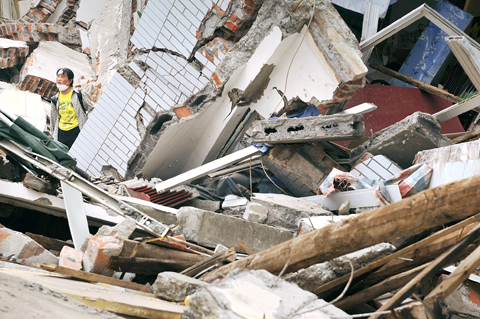Modern apartment buildings and schools crumbled, smoothly paved highways buckled and bridges collapsed — their flimsy construction no match for the awesome forces of nature.
As the death toll soars from Monday’s quake in Sichuan Province, the scale of the devastation is raising questions about the quality of China’s recent construction boom.
“This building is just a piece of junk,” one newly homeless resident of Dujiangyan yelled on Wednesday, her body quivering with rage.

PHOTO: AFP
Her family salvaged clothing and mementos from their wrecked apartment, built when their older home was razed 10 years ago.
“The government tricked us. It told us this building was well constructed. But look at the homes all around us, they’re still standing,” said the woman, who would give only her surname, Chen.
Three decades of high-paced growth have remade China. But as the widespread devastation from Monday shows, the pell-mell pace has led some builders to cut corners, especially in outlying areas largely populated by the very young and the very old.
“This new economy in China is not going up safely, it’s going up fast, and the two don’t go together,” said Roger Bilham, a professor of geological sciences at the University of Colorado at Boulder.
“You look at the buildings that fell and they should not have fallen,” he said. “This is a story that has been repeated throughout the developing nations.”
New buildings in Beijing are built to exacting codes to withstand earthquakes.
However, “anti-earthquake standards are not as strict in places like Sichuan as in Shanghai,” said Ren Bing, an architectural designer at Hong Kong-based China Construction International Co.
Monday’s temblor flattened smaller towns in the disaster zone like Yingxiu. In Beichuan, entire blocks of apartments seemingly disintegrated. In Dujiangyan city, there was little evidence of steel reinforcement bars in the concrete rubble.
Other infrastructure old and new suffered as well. Nearly 400 dams, most of them small, were damaged across Sichuan.
Since the 1976 quake in Tangshan killed at least 240,000 people, the government has tried to improve building standards.
“China has been taking earthquake safety very seriously in the past 10 to 20 years,” said Susan Tubbesing, head of the California-based Earthquake Engineering Research Institute. “From what I understand, the codes China has adopted in the past 20 years have been good, solid, seismic codes.”
Chinese building codes are designed according to the level of shaking expected from a major temblor, said Claire Souch, senior director of model management at the consulting firm Risk Management Solutions, which is working with the Chinese to assess the damage.
In Sichuan, new buildings are built to withstand a shaking level of 7, Souch said.
But the magnitude-7.9 quake produced a shaking intensity of 10 near the epicenter, which usually results in total collapses.
“Essentially what happened is the actual ground shaking has far exceeded the design code for that region,” Souch said.
Another problem is that actual enforcement of building codes varies. The construction boom that has underpinned much of the stunning growth has also been an invitation for corruption, with officials and developers colluding.
In big cities, authorities generally enforce regulations. But that isn’t always true in smaller cities. And in rural areas, it’s out of the question, says Andrew Smeall, an associate at Asia Society’s Center on US-China Relations in New York.
A commentary in Wednesday’s state-run China Daily did question the staggering death toll, especially in schools wrecked by the quake, suggesting an investigation might find builders to blame.

Kehinde Sanni spends his days smoothing out dents and repainting scratched bumpers in a modest autobody shop in Lagos. He has never left Nigeria, yet he speaks glowingly of Burkina Faso military leader Ibrahim Traore. “Nigeria needs someone like Ibrahim Traore of Burkina Faso. He is doing well for his country,” Sanni said. His admiration is shaped by a steady stream of viral videos, memes and social media posts — many misleading or outright false — portraying Traore as a fearless reformer who defied Western powers and reclaimed his country’s dignity. The Burkinabe strongman swept into power following a coup in September 2022

‘FRAGMENTING’: British politics have for a long time been dominated by the Labor Party and the Tories, but polls suggest that Reform now poses a significant challenge Hard-right upstarts Reform UK snatched a parliamentary seat from British Prime Minister Keir Starmer’s Labor Party yesterday in local elections that dealt a blow to the UK’s two establishment parties. Reform, led by anti-immigrant firebrand Nigel Farage, won the by-election in Runcorn and Helsby in northwest England by just six votes, as it picked up gains in other localities, including one mayoralty. The group’s strong showing continues momentum it built up at last year’s general election and appears to confirm a trend that the UK is entering an era of multi-party politics. “For the movement, for the party it’s a very, very big

ENTERTAINMENT: Rio officials have a history of organizing massive concerts on Copacabana Beach, with Madonna’s show drawing about 1.6 million fans last year Lady Gaga on Saturday night gave a free concert in front of 2 million fans who poured onto Copacabana Beach in Rio de Janeiro for the biggest show of her career. “Tonight, we’re making history... Thank you for making history with me,” Lady Gaga told a screaming crowd. The Mother Monster, as she is known, started the show at about 10:10pm local time with her 2011 song Bloody Mary. Cries of joy rose from the tightly packed fans who sang and danced shoulder-to-shoulder on the vast stretch of sand. Concert organizers said 2.1 million people attended the show. Lady Gaga

SUPPORT: The Australian prime minister promised to back Kyiv against Russia’s invasion, saying: ‘That’s my government’s position. It was yesterday. It still is’ Left-leaning Australian Prime Minister Anthony Albanese yesterday basked in his landslide election win, promising a “disciplined, orderly” government to confront cost-of-living pain and tariff turmoil. People clapped as the 62-year-old and his fiancee, Jodie Haydon, who visited his old inner Sydney haunt, Cafe Italia, surrounded by a crowd of jostling photographers and journalists. Albanese’s Labor Party is on course to win at least 83 seats in the 150-member parliament, partial results showed. Opposition leader Peter Dutton’s conservative Liberal-National coalition had just 38 seats, and other parties 12. Another 17 seats were still in doubt. “We will be a disciplined, orderly